Text and images by Craig Smith
Bonito, boneheads, Striped tuna, Laguna tuna, magneto. Whichever name you use these wonderful gamefish they are a late summer light tackle highlight of San Diego inshore waters. Bonito are an angler friendly fish that are usually aggressive and will strike just about any fly you can get in front of them. They strike hard and run fast and even small foot long specimens will often get a few yards into your backing. Bonito are also a great species to learn how to fight fast running fish before taking on bigger targets like tuna. You will learn quickly to keep your fingers away from the fast spinning reel handle when the fish runs, then grab it and start cranking when the fish slows and stops.

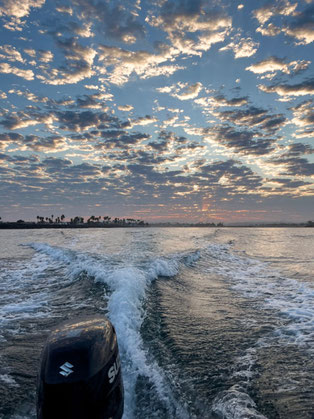
During some years small numbers of bonito may linger in San Diego Bay and Mission Bay but the peak time for local bonito angling runs from August through September when ocean temperatures are above 72 degrees F. Bonito in the 10lb+ range are often found offshore but the subjects of this article are the one to three pound fish ranging from 12” to 20” in length that often appear in large numbers just outside the kelp beds and within two miles of the beach.
In late summer water temperatures are at their peak warmth. Air temperatures are typically above 65 degrees F before dawn. The marine layer burns off early or is often absent with the sky filled with altocumulus or cirrocumulus clouds that are colorfully illuminated by the rising sun. The wind velocity is usually lower than 10 knots and commonly lower than 5 knots. The ocean swell is usually 2 feet or less unless pushed higher by a hurricane far south off of Baja California. These conditions make for pleasant days on the water.
While smaller bonito can be very exciting to catch, they do not punish gear and human bodies like the biggest specimens or their tuna relatives can. So these sleek bundles of energy can be fun to catch for anglers of all ages and skill levels. They can also be pursued with lighter, budget friendly gear. While I have used 5 weight rods for smaller bonito, we recommend 6 through 9 weight rods with a 7 or 8 weight rods being ideal if you are purchasing your first fly rod for targeting bonito with the fly. Almost any reel that you can purchase from a specialty fly shop that holds you fly line and at least 100 yards of 20 lb or 30 lb Dacron backing will be fine, even click and pawl drag designs used for trout and panfish. However, we recommend reels with a disc drag system which will provide a smoother brake. A sealed drag system is nice but not necessary as long as you care for your reel properly; and even sealed drag reels require proper care. Even a budget reel like the Redington Crosswater 7/8/9, which currently (August 2025) retails for $79.99 will suffice if cleaned properly after a day of saltwater angling.
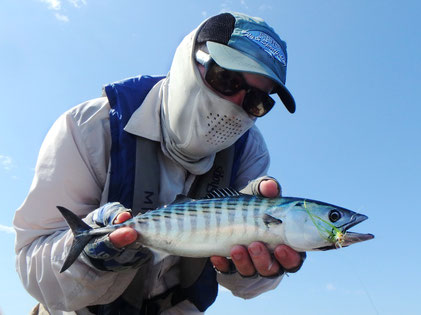
Ideally, anglers will have two types of fly lines with them when chasing bonito. A fast sinking line is the most important to have spooled up. A fast sinking line is useful for fish ranging from just below the surface down to about 20 feet below. You can control your depth by starting a retrieve immediately to fish just below the surface or waiting an appropriate time to let the fly and line sink to the desired depth. Integrated shooting taper lines like the Rio Striper, Rio Outbound Short, Scientific Anglers Sonar Titan Taper, Cortland Compact Sink, and similar designs are preferred over less costly standard weight forward sinking lines. The design of integrated shooting taper lines is conducive to making nearly effortless long casts. A floating line is the next most important type to have rigged up. A floating line can be used to fish poppers or crease flies. Floating lines can also be used to fish streamers just below the surface. An intermediate sinking line (sink rate of 1”-2” per second) can be used as an alternative to a floating line and and is preferred by some anglers because they are thinner than floating lines and cut through a breeze better. When a quick and steady retrieve is used a popper will still stay on the surface. For our Southern California ocean conditions saltwater specific or tropical fly lines are not necessary. If you are looking for a rod/reel/line kit that is ready to go The Redington Wrangler 8 weight kits at $329.99 retail price are a good starting point. These kits come with a floating line and you save about $50 over purchasing the components separately. A sinking line and possibly an extra spool (or reel) would still need to be purchased separately if you want to have both types of lines. My preference is to have two rod/reel/line setups rigged up and ready to go, but I understand that many folks may have a tight budget. If you want to step up from the lower cost gear, I suggest that you prioritize your spending on a better reel over a higher priced rod. There are a number of very good reels in the $120 to $250 range.
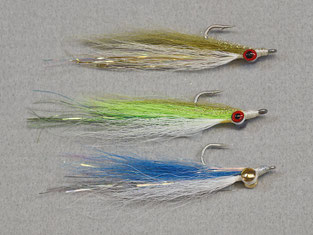
Bonito will eat almost any fly that moves quickly and has a bit of flash. I have caught bonito on crab patterns! However, a standard box of flies for bonito should be filled with assorted baitfish streamer patterns in sizes ranging 4 and up to 1/0 with fly lengths ranging from 2.5” to 4”. Most of the baitfish that bonito feed on, such as anchovies, have darker backs and lighter undersides, are shiny when near the surface and illuminated by the sun, and have a slim profile. There are hundreds patterns that are produced commercially that will work well. But you could start with a box with a few Clouser Minnows with blue/white, olive/white, green/white, chartreuse/white and/or all white color combinations in size 4 and size 2 and have all the flies you need.
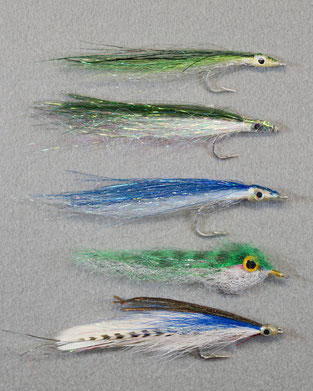

Topwater bonito action can be a hoot and small pencil poppers or foam poppers work very well. Another great pattern is the crease fly in sizes 4 and 2. The color rarely matters for your topwater offerings. I like colors that I can see easily and that have a reflective sheen so most of my poppers and crease flies have white or silvery bodies. I color the backs of many of the crease flies I make for artistic reason and because if I give some away to other anglers, they seem to have more confidence if the fly looks more fishy. But the majority of the crease flies I make for myself are all white.
If you want to catch bonito you need to find them first. One of the easiest ways to find bonito is to get information from someone with fresh on the water experience. Check with friends, local fishing tackle stores, or social media. For San Diego coastal waters some of the best sources of information are the sport fishing operations on San Diego Bay and Mission Bay that operate half day party boats. Check the websites for the sport fishing landings and monitor their daily dock counts to see if they are catching bonito in good numbers.
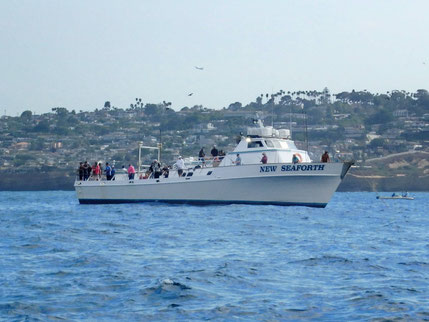
Then the next day follow or find where the half day boats are fishing. Sport boats carry large amounts of live bait that get used as both live bait and as chum which often hold bonito in their area for extended periods of time. Make sure you don’t encroach on their space though; a distance of a couple of hundred yards is often close enough to get into bonito that they are drawing in. Another way to find bonito is to look for collections of private boats that bunched up in an area. Anglers catching fish are often observed by other boaters who move in and the growing collection of boats draws in additional boats. When you see a collection of boats there are usually bonito, mackerel, and/or barracuda present. Just make sure you don’t get too close to other boats and interfere with their angling. When approaching a group of boats it is best to approach from an upwind/upcurrent position so you do not cut off their drift.
Other tried and true methods for finding bonito are to look for groups of diving birds; typically pelicans or terns when within a couple of miles of the San Diego County coastline. Sometimes you may observe bonito and other gamefish crashing into schools of baitfish, which can be an exciting sight to behold. We often troll small flashing lures like Krocodile spoons through areas we think may hold bonito including current seams, temperature breaks, and over high spots on the bottom that may hold baitfish. In my experiences, we have found more bonito using these methods than following sport fishing boats or finding collections of other private boats.
Bonito can move about very quickly in the constant search for food. Many a great day of bonito angling has been had where the bonito and their prey stay in an area for several hours. But it is a fairly common experience to hook one or two fish then get nothing further as the bonito move on. Often, an answer to this challenge is to toss some chum. The preferred chum is live anchovies. Many times, tossing out just two or three anchovies every minute or two is enough to keep the bonito nearby and interested. But if you do not have a bait well or don’t want to mess with hassles getting live bait and maintaining it in good condition, then chunked frozen anchovies can work well. Just toss a small handful of chunks over the side every few minutes.
A common question we get regarding bonito fishing, actually for all species, is: “what retrieve works best?” The answer to that question is: “the retrieve that works.” Seriously, that is the answer. Bonito often prefer the fly moving as fast as you can move it. Some anglers like to use a two handed retrieve where they hold the rod under an arm and use alternating hands to strip in line in as fast as possible. Single handed retrieves often work well, especially if you can move the fly at least three feet at a time with sharp tugs. This type of retrieve can simulate a darting baitfish. Retrieves that incorporate a couple of sharp pulls followed by a stop that allows the fly to drop can imitate a wounded baitfish. If you have bonito near the boat and you can’t seem to get a grab with standard retrieves you can make a short cast and sweep the rod. This will cause the fly to jump and move very quickly for the distance that the rod tip moves; however, you take away the straight line and rod connection to the fly which makes it more difficult to set the hook. Still, it can be worth a try. Counterintuitively, a do nothing retrieve works wonders at times. If you are tossing chunks of chum and bonito are slicing through your chum slick, try casting out a flashy fly and just letting it drift in the chum slick. Bonito and other game fish love easy prey and casting a fly into an area where they just chased baitfish to the surface and just letting it sink can draw strikes at times. I think the bonito are taking the sinking fly as crippled prey.

When fishing poppers or crease flies retrieve quickly to create as much ruckus on the surface as possible. Make as much commotion with the fly as you can. The splashing often attracts fish. It is a rare situation when you can create too much of a disturbance for bonito with topwater patterns. We have seen fish on the sonar holding 30ft below the surface refuse to move up to a fly we got 20ft down but would rocket to the surface for a frantically retrieved popper. Watching bonito attack topwater patterns can be very exciting. The fish will come up from below, blast them from the side, and attack from the behind. I have even seen bonito leave the water and come down on a popper or crease fly from above. It is not unusual to have bonito just blast a popper out of the way due to the violence of their attack, only to have another one or two or more immediately pounce on the fly. Even fishing a hookless popper can be very exciting. There have been times when I found the blowups entertaining enough to skip the catching and just work a popper with the hook point cut off and the bend.
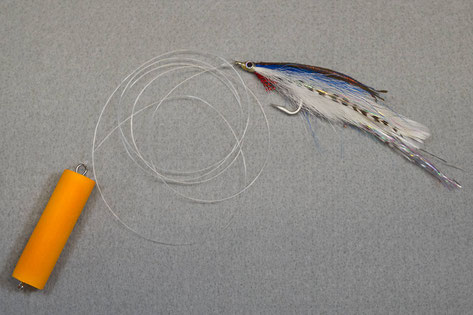
Rigging up for bonito can be a fairly simple affair. When using sinking lines and streamers 7 or 8 feet of 8lb to 12lb test nylon or fluorocarbon monofilament (yes fluoro is a mono - single - stand) is all you need. Create a loop knot in one end to attach to the end of the fly line and tie the other end to the fly, preferably with a loop knot to maximize the action of the fly. Optionally purchase a factory made tapered leader of about the same length. When casting poppers or crease flies use a tapered leader or make a simple two section leader with a 4ft butt section of 40lb nylon monofilament and loop 3ft of 8lb to 12lb tippet to that. Again attach the fly with a loop knot. Splasher rigs have long been a popular spin fisherman and work well with a fly rod. A splasher rig consists of some type of floating cylinder or hookless popper with about 3ft of leader attached to the back end and a fly or jig tied to the end of the leader. Fish that may not take a popper or lure (or fly) may grab the offering trailing the splasher. For a fly fishing setup, a hookless foam popper or foam cylinder serves as the splasher and you can trail any fly you feel comfortable casting with the rig. A simple solution for splasher is to buy a package of Fish-Skull Captain Dubiel’s Pop-N-Fly cylinders distributed by Flymen Fishing Company. They are available in two sizes and two highly visible colors with two to a package. Many fly shops stock these cylinders and they can also be purchased directly from Flymen Fishing. You can make your own by pushing longer sized shanks made for articulated flies through a foam cylinder or a long block of foam.

A bonus facet of chasing bonito is that other species may also be caught right along side them. It is fairly common to encounter mackerel with bonito. Larger mackerel can be as much fun as bonito. You may get into barracuda too. If fishing near kelp beds calico bass are commonly taken among the boneheads. Sometimes small yellowtail will put in an appearance. You just never know what might show up.

As with any species, there are a few things to keep in mind when angling for bonito. They have small sharp teeth which can tear up flies, though you might catch a couple of dozen before needing to replace the fly. Heavy bite or shock tippets are not necessary; however, you should check the last few inches of the tippet and the tippet to fly knot after every fish to ensure its integrity has not been compromised. Bonito have some very hard sections of the mouth and jaw so be sure to keep your hooks sharp. I usually do a hook point check before my first cast and after every fish. Bonito and other tunas require a lot of oxygen. When releasing them it is best to drop them head first into the water if you had to lift them out. That puts them immediately into a swimming mode and gets water immediately passing over their gills. Try to avoid dropping them onto the deck since their motor keeps running and the tail will continue to beat at high speed, causing the fishing beat itself up on the hard surface. I try to release bonito without removing them from the water whenever possible. Barbless hooks will enable a quick release and there are number of catch and release tools (e.g. ARC Dehooker, Baker Push Pull Dehooker, etc.) that are helpful. I carry a couple of different styles since some dehookers work better with some fly patterns but not so well with others. For example, ARC Dehookers won’t slide over a popper to the hook bend. You will want to have a soft towel handy to clean your hands of any slime or blood you get on you or your rod grip.
As I write this a few bonito are stating to show locally and hopefully their numbers continue to build since I am looking forward to another year of fast paced and sometimes frantic saltwater action. Bonito are a blast to catch, a challenge to track down, and can be caught and fought with successfully without top end gear.
